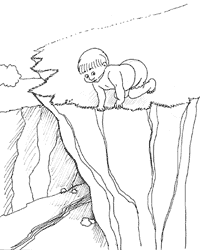On edge: Kiddies know where danger is

DRAWING BY DEBORAH DERR McCLINTOCK
Q. Would an unwatched toddler approaching the edge of the Grand Canyon perceive the danger and draw back? –B. Spock
A. This is what researcher Eleanor Gibson wondered while picnicking at the canyon rim, leading her and a colleague to develop a "visual cliff" test, says David Myers in Psychology. They placed 6- to 14-month-olds on a bright-checkered platform with a glass floor section extending out over an apparent drop-off. Then their mothers tried to coax the infants to crawl out over the "edge."
"Most refused to do so, indicating they could perceive depth." Newborn kittens, a day-old goat and newly hatched chicks respond similarly. "Each species, by the time it is mobile, has the perceptual abilities it needs," Gibson concluded.
Q. A computer-whiz friend says she's thinking of a number from 1 to 256, and challenges you to figure it out by asking her eight yes/no questions, and no more. Got a surefire strategy? –M. VosSavant
A. You can't just ask, "Is the number 1?," "Is the number 2?," etc. You'll run out of guesses. You need to be more systematic, using a "binary search": "Is the number higher than 128?" (256/2) "No." (Suppose she picked 100.) Then, "Higher than 64?" "Higher than 96?""Higher than 112?" "Higher than 104? "Higher than 100? "Higher than 98?" "Higher than 99?"
"Your number is 100."
Since 256 halved eight times equals 1, eight properly chosen questions will always pinpoint the mystery number.
Computer buffs will recognize that each of the 8 yes/no questions represents a "bit" of information, and 8 bits make up a "byte." So a byte of info selects among 256 possible outcomes, or roughly the number of letters, numbers, etc. on a computer keyboard.
Thus each typed character is roughly a byte of info, and a million such characters a megabyte, or enough to fill 50 pages of a telephone directory at 20,000 characters per page. For a gigabyte (today's home computers can store tens of gigabytes), make that 50,000 pages, or 50 fat, full, city phone books.
And that's quite a bit.
Q. Is there any truth to the old folk wisdom that people and their dogs tend to look alike? –S. Murray
A. Bulldog-faced Winston Churchill is often cited as an example of this but the problem is Churchill did not own a bulldog, says psychologist Stanley Coren in Why We Love the Dogs We Do. His beloved Rufus was a poodle, with narrow pointed muzzle, clear unwrinkled face and close-set eyes–not the image of his master.
But, argues Coren, people come to love their own face generally, so much so that some experts believe that children who look very much like one of their parents tend to be favored by that parent. And it might suggest that if the general features of a certain breed of dog match our own face, we'll feel a little warmer toward those dogs.
Not a lot of scientific work has been done on this, but Coren himself studied the reactions of 104 university women to slides of four different dog breeds. In general the women with longer hair that covered their ears and framed their face preferred the English Springer Spaniel and the Beagle with their longer lopped ears. They rated the dogs as more likable, friendly, loyal, and intelligent.
Women with shorter hair and visible ears, however, favored the Siberian Husky and the Basenji with their clearly visible pricked ears. "We are not talking about a universal preference, but it is statistically reliable."
Q. How has misunderstanding the "law of large numbers" been the ruin of many a gambler? J. Unitas
A. This principle states that the more times you flip a "fair" coin, the closer you'll get to 50 percent heads, 50 percent tails, say Jeffrey Bennett and William Briggs in Using and Understanding Mathematics: A Quantitative Reasoning Approach. But these are percentages: The actual numbers will likely drift farther apart, say 4H-6T after 10 flips, then 45H-55T, 480H-520T, etc., even though the percentage of heads jumps from 40 percent to 45 percent to 48 percent, nearing 50 percent.
Misunderstanding this, many people will believe that with only 480 heads out of 1000, "heads are due" and are therefore more likely on subsequent flips– the classic "gambler's fallacy." In fact, the 20-heads' deficit (off the 500H ideal split) isn't more likely to be made up but to be "watered down" as a percentage as the number of flips goes to 10,000, 100,000 and beyond. Yet all along the way, for every flip a head and a tail remain equally likely.
Nevertheless, many gamblers will tend to think that a streak of bad luck makes them "due" for a streak of good luck. But don't bet on it!
Send Strange questions to brothers Bill and Rich at .